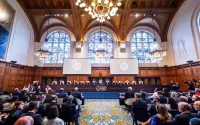3 October 2006Planet Ark
In the past decade, the level of ozone in the Earth's atmosphere has fallen by about 0.3 percent, increasing the risk of skin cancer, cataracts and harm to marine life, ESA added.
The presence of a hole in the ozone layer over the Antarctic was first recognised in 1985. The World Meteorological Organisation (WMO) said earlier this month that the hole was nearing its record size of 29 million square km (11.20 million square miles) set in 2000.
The depth of the hole, however, was greater this year than in 2000, bringing the amount of lost ozone to 40 million tonnes on Oct. 2, beating 2000's record of 39 million tonnes, ESA said in a statement.
The ozone loss over Antarctica is calculated by measuring the hole's area and depth.
"Such significant ozone loss requires very low temperatures in the stratosphere combined with sunlight," ESA Atmospheric Engineer Claus Zehner said.
"This year's extreme loss of ozone can be explained by the temperatures above Antarctica reaching the lowest recorded in the area since 1979," Zehner added.
The WMO and the UN Environment Programme (UNEP) said in August that the protective layer would likely return to pre-1980 levels by 2049 over much of Europe, North America, Asia, Australasia, Latin America and Africa.
In Antarctica, the agencies said ozone layer recovery would likely be delayed until 2065. Chlorofluorocarbons (CFCs) containing chlorine and bromine have been blamed for thinning the ozone layer because they attack ozone molecules, causing them to break apart.
Many CFCs, once commonly used in refrigeration, air conditioning and industrial cleaning, were banned by the 1985 Vienna Convention and its Montreal Protocol of 1987. Despite that, CFCs have still not vanished from the air, ESA said.






